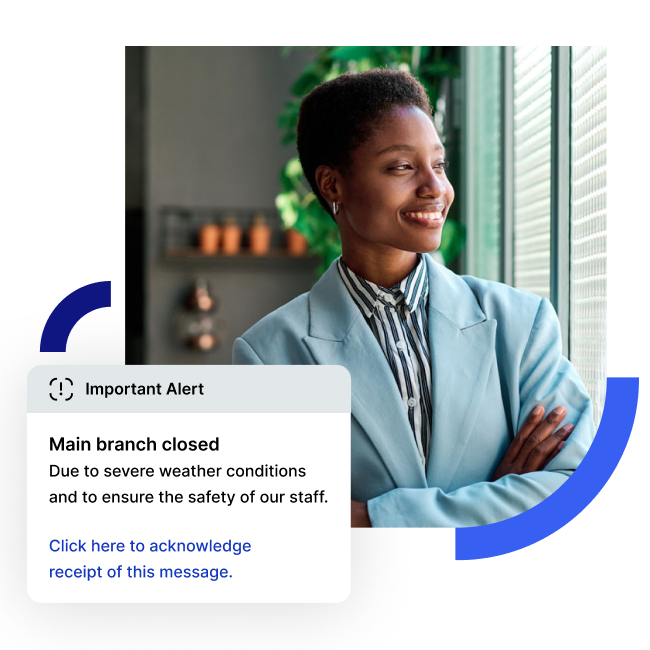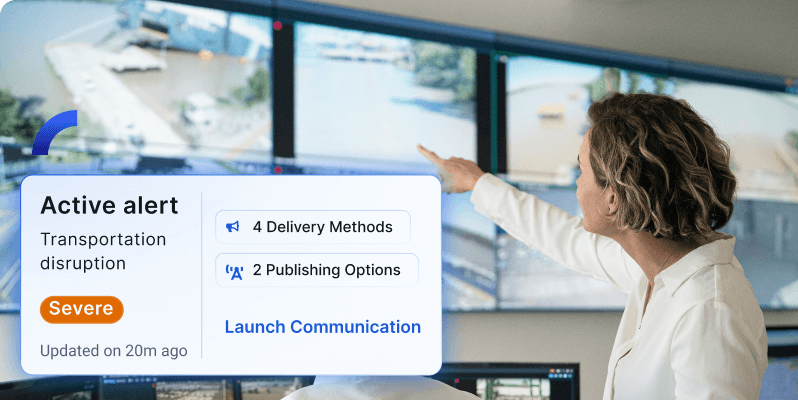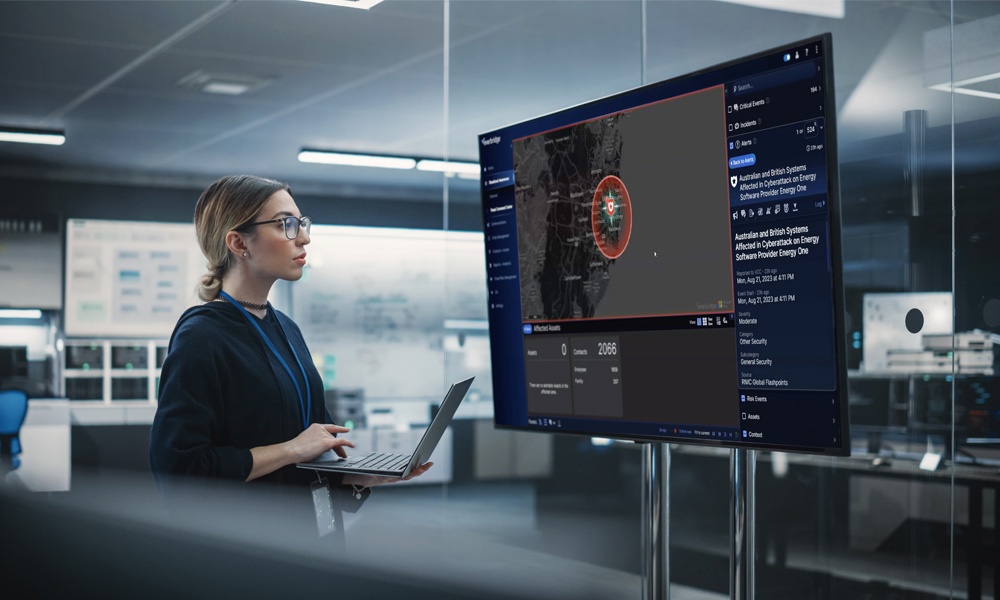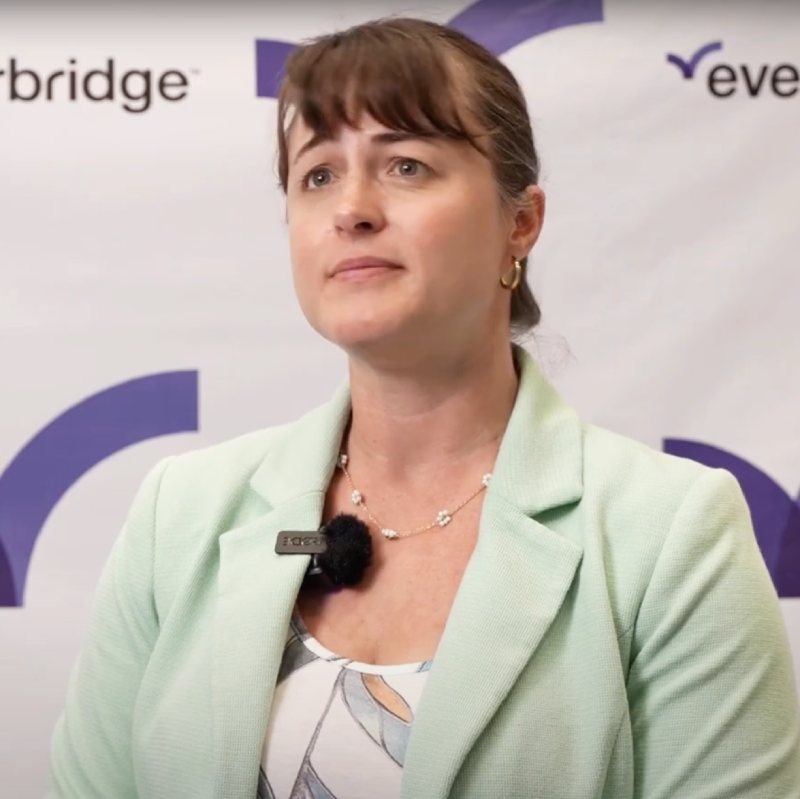Empower your financial services organization with Everbridge
The financial services industry operates under intense regulatory and stakeholder scrutiny, facing immense pressure to achieve and maintain operational resilience. This is a formidable challenge due to the intricate web of processes, complex technology infrastructures, and organizational silos that characterize the industry.

Keep your people safe and your organization running
Everbridge helps financial institutions build resilience with our industry-leading High Velocity Critical Event Management™ platform, Everbridge 360. Powered by Purpose-built AI, it enables organizations to respond swiftly and effectively to critical events, safeguard employees, secure sensitive client information, and minimize operational disruptions. Everbridge enhances resilience and compliance with evolving regulations by automating threat detection, crisis management, incident response, communications, and reporting. With Everbridge, financial institutions can streamline workflows, break silos, and improve responses to critical events.

Know earlier, respond faster, and improve continuously in how you deal with threats
Stay ahead of physical and digital threats like weather events, active assailants, or IT disruptions with our High Velocity Critical Event Management™ platform, Everbridge 360.

1. Know earlier
With advanced business continuity planning and leading risk intelligence, you’ll get real-time insights to detect threats wherever they arise, helping you quickly identify risks to your people and operations.

2. Respond faster
When critical events happen, speed matters. Our Alert Management feature enables seamless, “one-click” responses, from emergency communications to clear instructions, keeping your employees safe and your business protected.

3. Improve continuously
Adapt and improve with our detailed after-action reports, response analytics, and interactive dashboards. Turn data into insights to strengthen your organization’s resilience for the future.
Proactive risk insights
Leverage comprehensive risk data and actionable insights to identify and address potential threats in real time.
Streamlined emergency response
Utilize automated workflows to reduce risk exposure and boost operational efficiency during critical moments.
Real-time asset tracking
Monitor employee and asset locations in real time to safeguard resources and ensure business continuity.
Simplified compliance
Meet industry standards with streamlined processes and timely, accurate communication that ensures regulatory compliance.

How it works
Everbridge 360 helps you navigate crises and mitigate risks confidently by providing real-time threat detection, automated emergency alerts, and unified communication systems. It enables organizations to identify potential threats early, safeguard client data, and respond swiftly to minimize disruptions. Everbridge 360 ensures rapid, informed decision-making, protects insurance professionals, minimizes operational disruptions, and supports the continuity of critical services during emergencies.
Independent Bank uses Everbridge for faster responses and better outcomes
Independent Bank shares how Everbridge has revolutionized their critical event response with faster communication, improved organization, and seamless mobile notifications.
“It’s a great company, it’s a great program, the service is wonderful, and we wouldn’t be where we are today without it.”
– Cara Brownell, AVP Solutions Manager, Independent Bank
A stronger focus on regulation
An operational resilience framework is a far-reaching and complex undertaking, and whilst some firms are already in implementation, a large portion of the sector have yet to start. Operational resilience is no longer a ‘nice to have’, it’s a regulatory requirement in many jurisdictions around the world. Some examples, but not all, are given below:
U.S. Securities and Exchange Commission (SEC)
The SEC, Federal Reserve, FDIC, OCC, and FFIEC emphasize operational resilience in the financial sector. Rising regulatory expectations highlight the need for a unified critical event management platform to streamline operational risk, response benchmarks, tracking, and audits. Regulators focus on minimizing outages and ensuring oversight, strengthening business continuity and crisis management across the industry.
The European Union (EU)
The European Union (EU) introduced the Digital Operational Resilience Act (DORA) in 2025 which introduces a unified framework to boost the operational resilience of digital systems in financial institutions. Organizations must ensure ICT systems are resilient, secure, and compliant with strict standards. Compliance demands include documentation of ICT assets, encryption policies, network security, and data transfer protocols, driving significant changes to ensure continuity, availability, and robust data security measures.
United Kingdom (UK)
The United Kingdom (UK), through the Bank of England (BoE), the Financial Conduct Authority (FCA), and the Prudential Regulation Authority (PRA), introduced the Operational Resilience and Business Continuity framework. This framework aims to ensure financial institutions can withstand disruptions, safeguard critical business services, and maintain market stability. It focuses on risk management, recovery planning, and enhancing overall operational robustness across the sector.
Australian Prudential Regulation Authority (APRA)
The Australian Prudential Regulation Authority (APRA) introduced standards to enhance the financial resilience of regulated entities. These standards focus on risk management, crisis preparedness, and operational continuity, ensuring businesses can withstand disruptions and safeguard stakeholders. By mandating robust governance, recovery planning, and stress testing measures, APRA aims to strengthen the stability and reliability of Australia’s financial sector.
Hong Kong Monetary Authority (HKMA)
The Hong Kong Monetary Authority (HKMA) has introduced financial standards to bolster the stability and resilience of the banking sector. Focused on risk management, liquidity, and cybersecurity, these measures ensure institutions can manage disruptions effectively. By promoting robust governance, operational continuity, and anti-money laundering practices, the HKMA aims to uphold investor confidence and maintain Hong Kong’s position as a global financial hub.
Monetary Authority of Singapore (MAS)
The Monetary Authority of Singapore (MAS) has implemented financial standards aimed at strengthening risk management, operational resilience, and cybersecurity within the financial sector. These regulations promote innovation while ensuring stability and safeguarding stakeholders. By encouraging digital transformation and robust governance, MAS supports the growth of fintech and maintains Singapore’s standing as a trusted and competitive global financial center.
Reach the highest level of resilience with BC in the Cloud (BCIC)
As the frequency and severity of incidents increase, financial services institutions need to reach new levels of readiness and become more agile when responding to regulator requests. BCIC was built to ensure financial services organizations can take their BC/DR programs beyond operational resilience to reach the highest standards of readiness.

How your financial services organization can benefit from using Everbridge
Critical event management
Protect your employees and sensitive data while maintaining business continuity with faster threat detection, automated alerts, and seamless communication during emergencies.
Business continuity
Safeguard client services and ensure smooth operations with tools that support proactive planning and enable quick, effective responses to any disruption.
Travel risk management
Provide peace of mind for traveling and remote employees with timely alerts, actionable guidance, and risk avoidance measures that ensure their safety.
Digital operations
Deliver consistent service and client satisfaction by preventing system downtime, resolving issues quickly, and keeping critical systems running efficiently.

Everbridge named a Leader in The Forrester Wave™: Critical Event Management
Empower resilience with the leading critical event management platform.

Outcome
Financial services organizations utilizing Everbridge experience seamless communication during emergencies allowing for informed decision-making and swift coordination, minimizing confusion and delays. With operational disruptions significantly reduced by automating workflows and safeguarding sensitive assets, organizations maintain business continuity even during unforeseen events. This proactive approach strengthens overall resilience, protects client trust, and ensures uninterrupted services in a highly demanding and regulated industry.
Featured customer stories

Santander saves time and cost with critical event management
Within a single platform, Santander can now coordinate all response activities, teams, and resources to accelerate recovery times and maintain command and control during a crisis.

Everbridge provides Public Service Credit Union (PSCU) with a flexible solution
Everbridge provides PSCU with an easy-to-use solution that can be quickly scaled depending on incident and event type. PSCU utilizes the system to keep employees safe.
Featured resources

Global Threat Outlook 2025
Download our newly released report “Global Threat Outlook 2025.” The report provides essential insights and strategies for navigating the intricate landscape of global threats.

2025 Global Enterprise Resilience Report
Download the report for analysis on industry surveys, insights into the threats resilience leaders are watching, and ways to adopt a more flexible and effective approach to readiness.

Understanding DORA: How to operationalize digital resilience
In an interconnected world, digital resilience is crucial for navigating crises and safeguarding financial and security assets.

Everbridge for NIS2, DORA, Cyber Resilience Act
Leverage Everbridge to operationalize your response to EU regulations including NIS2, DORA, and the Cyber Resilience Act. Enhance your compliance and strengthen your cyber defenses.

DORA FAQ for financial institutions
Everbridge provides customers with a complete solution that digitizes organizational resilience. As a leader in the field, Everbridge offers a suite of powerful tools to help financial organizations know earlier, respond faster, and improve continuously.

The ultimate operational resilience handbook
A practical guide for risk professionals to manage the multiple dimensions of operational resilience.

Unlocking DORA, from policy to operationalization
Watch an insightful webinar that delves into the challenges faced by financial institutions in implementing strategies and tactics to comply with the European Union Directive on Operational Resilience Act (DORA).

The roadmap to true organizational resilience: Best practices for success
Watch an engaging webinar led by experts from Everbridge, Deloitte Advisory, and New York Life, as we explore the essential steps and strategies required to build true organizational resilience.


